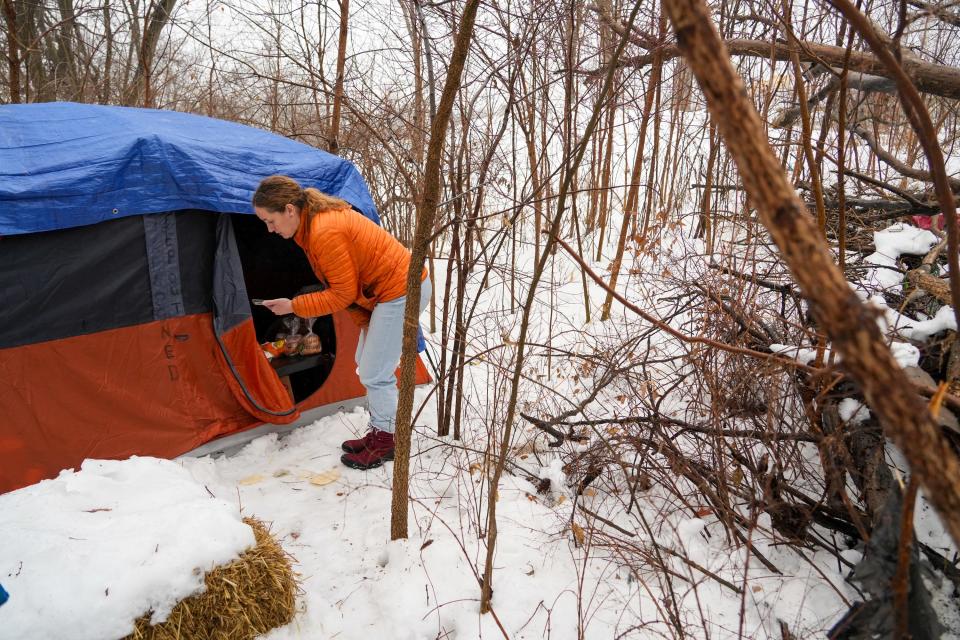Homelessness in Polk County hits a record high, new count shows. What's driving the rise:
Homelessness in Polk County has reached a record level, according to an annual report from the county's homelessness planning organization, Homeward.
Housing agency leaders who conducted a point-in-time count during 24 hours on Jan. 24 and Jan. 25 found approximately 715 homeless people. That's an 11% increase from last year's 644 and about an 18% jump from the 606 reported in 2022.
The number of unsheltered individuals also went up 14% to 147 from 129 in 2023. Emergency shelter and housing providers also said they were operating at near 100% capacity on the night of Jan. 24, with another 679 people temporarily housed in quarters usually allocated to chronically homeless people, according to the report.

Experts point to lack of affordable housing, other resources
Angie Arthur, executive director of Homeward, said she was not surprised by the figures. Polk County continues to see a steady rise in people experiencing homelessness because there aren't enough resources — especially affordable housing — to meet their needs, she says.
"Our resources haven't increased comparably," she said, adding that many federal and state dollars dispersed during the COVID-19 pandemic to tackle housing insecurity have ended or are ending, removing a safety net for those in search of stability.
One program that will wrap up by next fall is the Iowa Rapid Rehousing Project, a state initiative launched in 2022 and funded by federal dollars through the Emergency Rental Assistance (ERA2) program. The project — which promised to help homeless families find housing, schools and jobs and shoulder moving costs — will end in September 2025.
More: After first year of Uplift's guaranteed income program, what has it done for participants?
Arthur said she believes consistent investment is key to solving the county's housing issues and pointed to previous efforts that have at least stabilized the numbers of youth and veterans experiencing homelessness. Polk County in 2019 was awarded $2 million in grant funds by the federal government's Youth Homelessness Demonstration Program. That money was used to bolster services such as mental health for youth under the age of 25. City investment, along with state and federal money, also has been directed to combating veteran homelessness.
"We know that when we have an appropriate level of resources that we can make a difference in our community for our community members that are experiencing homelessness," Arthur said.
What is the point-in-time count of homeless people?
Every year, Homeward partners with other area housing agencies to conduct the point-in-time count, which seeks to show the total number of homeless people on a single night in January. The count — which this year was held over a 24-hour period starting Jan. 24 — is required by the U.S. Department of Housing and Urban Development. It serves as a snapshot of people's experiences, current living situations and resources available in communities. County housing leaders typically hold a separate count in July.
During the count, homeless outreach staff and volunteers visit unsheltered residents — those who live in cars or encampments or on the street — and conduct surveys aimed to cast light on the county's housing issues. Staff and volunteers often give away gift cards and care packages with personal toiletries.
More: We tagged along on a biannual count of Polk County's homeless people. Here's what we saw:
What else does the new homelessness count show?
With insight from the partner nonprofit Institute of Community Alliances, Homeward pulled the following highlights:
Eighty-nine people reported they were fleeing from domestic violence, setting a record for the county. Housing leaders saw a 37% increase from last year's reported total of 65, which was then considered the highest number in the past six years.
Eighty-four percent of unsheltered individuals reported their last permanent address as Polk County, while 12% said they had previously lived in another Iowa county. Only 4.5% of individuals were found to have come from out of state.
Similar to other U.S. cities, Black residents in Polk County are disproportionately affected by homelessness. According to the PIT count, 22% of participants surveyed were Black, while Black residents make up about 9% of the county's population.
How individuals can help address homelessness
Arthur said people can help to address homelessness in several ways, such as by volunteering their time, money or skills to housing agencies such as Homeward or other service providers, especially in their communities. More information about Homeward can be found online at www.homewardiowa.org.
F. Amanda Tugade covers social justice issues for the Des Moines Register. Email her at ftugade@dmreg.com or follow her on Twitter @writefelissa.
This article originally appeared on Des Moines Register: Des Moines metro homeless numbers soar to record high, new count shows

